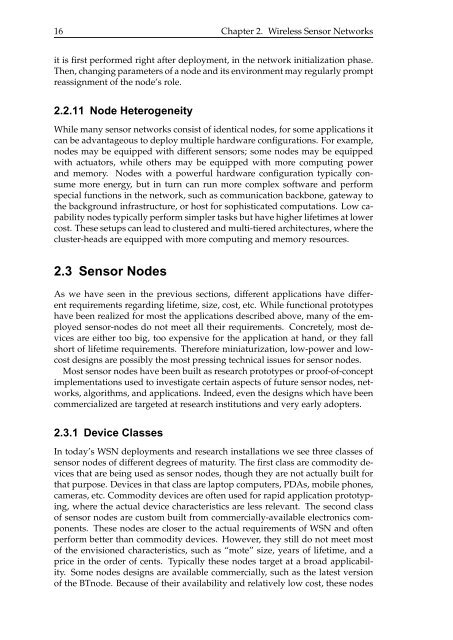A State-Based Programming Model for Wireless Sensor Networks
A State-Based Programming Model for Wireless Sensor Networks
A State-Based Programming Model for Wireless Sensor Networks
You also want an ePaper? Increase the reach of your titles
YUMPU automatically turns print PDFs into web optimized ePapers that Google loves.
16 Chapter 2. <strong>Wireless</strong> <strong>Sensor</strong> <strong>Networks</strong><br />
it is first per<strong>for</strong>med right after deployment, in the network initialization phase.<br />
Then, changing parameters of a node and its environment may regularly prompt<br />
reassignment of the node’s role.<br />
2.2.11 Node Heterogeneity<br />
While many sensor networks consist of identical nodes, <strong>for</strong> some applications it<br />
can be advantageous to deploy multiple hardware configurations. For example,<br />
nodes may be equipped with different sensors; some nodes may be equipped<br />
with actuators, while others may be equipped with more computing power<br />
and memory. Nodes with a powerful hardware configuration typically consume<br />
more energy, but in turn can run more complex software and per<strong>for</strong>m<br />
special functions in the network, such as communication backbone, gateway to<br />
the background infrastructure, or host <strong>for</strong> sophisticated computations. Low capability<br />
nodes typically per<strong>for</strong>m simpler tasks but have higher lifetimes at lower<br />
cost. These setups can lead to clustered and multi-tiered architectures, where the<br />
cluster-heads are equipped with more computing and memory resources.<br />
2.3 <strong>Sensor</strong> Nodes<br />
As we have seen in the previous sections, different applications have different<br />
requirements regarding lifetime, size, cost, etc. While functional prototypes<br />
have been realized <strong>for</strong> most the applications described above, many of the employed<br />
sensor-nodes do not meet all their requirements. Concretely, most devices<br />
are either too big, too expensive <strong>for</strong> the application at hand, or they fall<br />
short of lifetime requirements. There<strong>for</strong>e miniaturization, low-power and lowcost<br />
designs are possibly the most pressing technical issues <strong>for</strong> sensor nodes.<br />
Most sensor nodes have been built as research prototypes or proof-of-concept<br />
implementations used to investigate certain aspects of future sensor nodes, networks,<br />
algorithms, and applications. Indeed, even the designs which have been<br />
commercialized are targeted at research institutions and very early adopters.<br />
2.3.1 Device Classes<br />
In today’s WSN deployments and research installations we see three classes of<br />
sensor nodes of different degrees of maturity. The first class are commodity devices<br />
that are being used as sensor nodes, though they are not actually built <strong>for</strong><br />
that purpose. Devices in that class are laptop computers, PDAs, mobile phones,<br />
cameras, etc. Commodity devices are often used <strong>for</strong> rapid application prototyping,<br />
where the actual device characteristics are less relevant. The second class<br />
of sensor nodes are custom built from commercially-available electronics components.<br />
These nodes are closer to the actual requirements of WSN and often<br />
per<strong>for</strong>m better than commodity devices. However, they still do not meet most<br />
of the envisioned characteristics, such as “mote” size, years of lifetime, and a<br />
price in the order of cents. Typically these nodes target at a broad applicability.<br />
Some nodes designs are available commercially, such as the latest version<br />
of the BTnode. Because of their availability and relatively low cost, these nodes
















